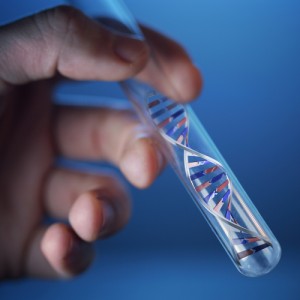Annual growth rates of 11% or more is predicted for molecular diagnostics in coming years
Just as consolidation and acquisitions reshaped the in vitro diagnostics (IVD) manufacturing industry and concentrated market share among just a handful of multi-billion dollar IVD giants, a similar consolidation can be seen in the molecular diagnostics sector. Today it is estimated that just nine global companies control 75% of the molecular diagnostics market.
That market concentration means clinical laboratories and anatomic pathology groups have a just a handful of primary vendors from which to purchase many of the molecular diagnostic assays and genetic tests that are used most frequently in clinical care.
Frost and Sullivan published a detailed study about the molecular diagnostics marketplace. The consulting firm estimated that worldwide sales of molecular diagnostics totaled $4.1 billion in 2010. By contrast, total IVD sales globally were about $48 billion in 2010. That total includes the routine, reference, and esoteric test kits, reagents, and supplies used every day by medical laboratories.
True to past predictions, the spectacular growth rates in molecular diagnostic tests and genetic assays will continue well into the future. Frost & Sullivan predicts that, by 2014, those revenues will exceed $6.2 billion. Compound annual growth rate (CAGR) is projected at more than 11%, a growth rate which is well above the low single-digit CAGR for routine chemistry, hematology, and immunoassay products.
Expanding Molecular Diagnostics Infectious Disease Market
The big dog of molecular diagnostics is infectious disease testing, which makes up about 60% of overall molecular diagnostic market revenues. Frost & Sullivan says that companies offering molecular products in this sector are developing and marketing test kits and supplies to support testing for human immunodeficiency virus (HIV), human papilloma virus (HPV), hepatitis B and C (HBV/HCV), and CT/NG.

Globally, molecular diagnostics is the fastest-growing testing sector for in vitro diagnostics (IVD) manufacturers. In a recent report on the molecular diagnostics marketplace, Frost & Sullivan predicted a compound annual growth rate (CAGR) of 11% from now through 2014. (Photo by Medifoslab.com.)
Molecular diagnostics manufacturers with products for infectious disease testing are employing one of two targeted strategies, according to Frost & Sullivan. One range of applications is used for identifying and profiling causative agents of infectious disease. The other range of applications is used for quantifying pathogens to monitor durability of therapy.
“[M]ost of these testing areas are very mature, with growth rates settling around 5%,” stated Jonathan Witonsky, who is Industry Manager with the Frost & Sullivan United States Healthcare Practice. The exception is the HPV molecular diagnostic market .It represents a significant market opportunity, as annual growth rates are expected to hold as high as 20% through 2014.
The use of nucleic acid mediated molecular diagnostics testing is allowing researchers to begin to overcome earlier limitations. “Costs-per-sample and manual requirements have fallen with the adoption of novel genomics technologies and improvements in automation,” observed Witonsky.
Nine companies control more than 75% of the molecular diagnostics market. These include:
- Roche Diagnostics, division of Roche Holdings (SIX: ROG.VX)
- Qiagen NV (NASDAQ: QGEN)
- Gen-Probe Incorporated (NASDAQ: GPRO)
- Abbott Diagnostics, (NYSE: ABT)
- Siemens (NYSE: SI)
- Becton Dickinson (NYSE: BDX)
- Cepheid (NASDAQ: CPHD)
- bioMerieux (EN Paris: BIM:FP)
- Beckman Coulter (NYSE:DHR)
Roche tops the list of large molecular diagnostics companies with a market share of 30% and an extensive product portfolio. Among the Roche products are molecular diagnostic tests for oncology, virology, microbiology, and blood screening.
In its study, Frost & Sullivan stated that four areas of molecular diagnostics are expanding the fastest. They include, genetic testing, prenatal diagnostics, cancer diagnostics, and near-patient applications.
Where Molecular Diagnostics Testing Goes Next
New molecular diagnostic tests are regularly introduced to the market for screening or diagnosing a wide range of patient types for numerous diseases, Witonsky pointed out. Manufacturers are rapidly introducing molecular diagnostic tests for additional types of infectious disease. Following is a list of such tests that are relatively new to the market:
- West Nile Virus
- Clostridium difficile (C-diff)
- methicillin-resistant Staphylococcus aureus (MRSA)
- respiratory syncytial virus
- influenza
- pneumonia
- Trichomonas vaginalis
- genital mycoplasma
- herpes simplex virus
- norovirus
- rotavirus
- tuberculosis
- meningitis.
Clostridium difficile and MRSA, two tests for healthcare-associated infections (HAI), have seen the highest level of adoption. In the U.S. alone, direct medical costs attributed to HAIs total as much as $34 billion. This creates the incentive for providers to use molecular diagnostic-based screens for risk mitigation.
Approximately 800 medical laboratories—600 hospital and 200 independent—now perform high-volume testing requiring automated molecular diagnostic testing platforms and systems for simplifying and accelerating specimen preparation.
The rapidly changing and increasingly competitive landscape of diagnostics continues to stimulate increased demand for molecular testing, particularly in the area of infectious disease. Consequently, accelerating advances in technology and genetic and proteomic research are sure to reveal new and untapped opportunities in molecular diagnostic testing.
—Pamela Scherer McLeod
Related Information:



